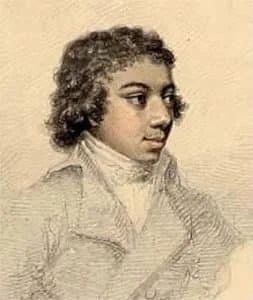DAILY DOSE of BEETHOVEN (May 27, 2020)
Beethoven's Violin Sonata No. 9, Op. 47 in A major (premiered 1803), represents a great breakthrough in composition on many levels. It is noted for its technical difficulty, unusual length and emotional breath. Today, we will concentrate primarily on the first movement.
Beethoven met the great mulatto (of mixed black and white parentage) violinist and composer, George Bridgetower, in Vienna, and admired his musical capabilities. Bridgetower was born in Poland to a Polish mother and a father who laid claim to an African prince-hood, by way of Barbados. George had the best musical training, including training from a former Mozart student, Thomas Attwood. He composed and played in the world premieres of Haydn's symphonies in London, starting at the age of 11.
Beethoven dedicated this sonata to Bridgetower, and they performed its world premier on May 24th, 1803, as one of the early 8 A.M. morning concerts, at the Augarten Theater, run by Ignaz Schuppanzigh, who premiered most of Beethoven's string quartets. Despite the early hour, it was well attended, including by Prince Lichnowsky, who had introduced Schuppanzigh and Beethoven. Also in attendance are the British ambassador, and Prince Lobkowitz, another patron of Beethoven.
How daring was it for him to play with a man of partially African descent at the time? While liberal feelings ran high, the enlightened outlook of Mozart's patron, Emporer Joseph II is in retreat. The highly cultured Angelo Soliman (born 1721, from present-day Cameroon, Africa) was tutor to a prince, and friend to both Joseph II and Mozart. He was also a prominent Viennese Freemason and a symbol of interracial progress. Despite that, he met the most horrifying fate. Some hated the characterization of him as the Father of Masonic Thought. After his death in 1796, he was skinned, stuffed, decked out with ostrich feathers and beads, and displayed among stuffed animals as part of the cabinet of curiosities, in the Imperial Natural History Collection, as the "mummified moor." His stuffed body was on display in Vienna when Beethoven and Bridgetower premiered the sonata. So, it was not only daring, but probably dangerous. One cannot help but wonder if the extreme passion of the first movement, at least partially expresses Beethoven's anger over such blatant injustice towards darker-skinned people.
Beethoven marked for the first movement: Sonata per il Pianoforte ed uno violino obligato in uno stile molto concertante come d’un concerto—It was to be played, as if it were a violin concerto. Bridgetower's skills must have been prodigious. He sight-read the work, having had no time for rehearsal. Exactly how difficult is it? A present day musician writes: "As a violinist, it’s like fighting an octopus in a phone booth with a pencil." The violin has double stops, pizzicato double stops, cross-string bowing, and many other technical difficulties. Moreover, it is very passionate, and very different from any violin music anyone had ever before heard. The conceptual challenges matched the technical.
Beethoven gave it an ironic dedication: Sonata mulattica composta per il mulatto Brischdauer [Bridgetower], gran pazzo e compositore mulattico (Mulatto Sonata composed for the mulatto Brischdauer, great madman and mulatto composer).
What does that mean? He might be referring to the Sonata as mulatta because it was composed in such a hurry that he took a movement from another sonata, and used it as the third and final movement. Maybe not. Who is the great madman and mulatto composer: Bridgetower or Beethoven himself? It's a wild, roller-coaster ride of a piece, and Beethoven had to know that many would regard him as "mad" for composing it.
Unfortunately, the two had a falling out afterwards, supposedly over a woman, and Beethoven changed the dedication to Rodolphe Kreutzer. That is unfortunate. Kreutzer refused to play the work, and told Hector Berlioz that it was "outrageously unintelligible" and that Beethoven did not know how to wrote for violin. This great violin sonatas probably should’ve remained the Bridgetower Sonata!
TOLSTOY GETS IT WRONG, AGAIN!
You may recall Count Leo Tolstoy's objections to the 4th movement of the Ninth Symphony, as " Bad art". (Refer back to May 1 post).
We can relax that Tolstoy admired the Kreutzer Sonata. So much so, that he wrote a book by that name. However, in that book, the sonata whips up such passion in a man that he murders his wife. That’s not exactly what Beethoven had in mind. One wonders why Tolstoy continues to have such virulent reactions to Beethoven. The conclusion to be drawn is that Beethoven’s passions for humanity drew its share of foes.
We provide two very different performances of the first movement. The first is by the great Jewish Russian violinist, Leonid Kogan, who is accompanied by his daughter, Nina, on the piano. Please do not worry about the sound quality: just feel the energy, and ask yourself what the Hell is going on?!
For contrast, we provide this performance by Norbert Brainin and Gunther Ludwig from 1988. Although it is slower, it is no less fiery, although perhaps a bit more stately.
We tried to find recordings or scores by Bridgetower, who was a composer, but could not. If any readers have access, please post!
Photos: 1 and 2 George Bridgetower. 3: Angelo Soliman RIP



